Spectral and Spatial Dependencies in the Validation of Satellite-Based Aerosol Optical Depth from the Geostationary Ocean Color Imager Using the Aerosol Robotic Network
Abstract
:1. Introduction
| Authors | Year | Satellite/Model Dataset Name | Spectral Selections of Aeronet | Spatiotemporal Criteria for Validation |
|---|---|---|---|---|
| Ahn et al. [3] | 2014 | OMI OMAERUV AODs at 388 nm | AOD380 and AOD440 | 40 km spatial radius with a ±10 min time window |
| Cesnulyte et al. [18] | 2014 | ECMWF reanalysis AODs at 550 nm | AOD550 and AE400-870 | 80 km spatial radius with a ±30 min time window |
| Choi et al. [29] | 2019 | GOCI YAER AODs 550 nm | Interpolate AERONET data to the satellite | 25 km spatial radius with a ±30 min time window |
| Huang et al. [28] | 2016 | Suomi-NPP VIIRS AOT at 11 wavelengths and evaluated at 550 nm | AERONET AODs at 10 wavelengths from 340 nm to 870 nm plus 1640 nm | 27.5 km spatial radius with a ±30 min time window |
| Ichoku et al. [20] | 2002 | MODIS AODs at 660 nm | AOD670 | 50 km × 50 km space with a ±30 min time window |
| Ichoku et al. [21] | 2003 | MODIS AODs at 470 and 660 nm | AOD440 and AOD670 | |
| Ichoku et al. [22] | 2005 | MODIS AODs at 470, 550, and 660 nm | AOD440, AOD670, and AOD870 | |
| Kahn et al. [26] | 2005 | MISR AODs | All AERONET AODs | One central and eight surrounding 17.6 km retrieval regions with a 2 h time window |
| Kahn et al. [27] | 2010 | |||
| Lee et al. [19] | 2013 | MODIS, MISR AODs 550 nm, GOCART model AODs 550 nm | AOD500 and AOD675, or AOD440 and AOD500 in the absence of AOD675, or AOD440 and AOD675 in the absence of AOD500 | 2.8° × 2.8° grid |
| Park et al. [17] | 2020 | MODIS AODs at 550 nm | AOD500 | Collocation time and range were tested in this paper |
| Petrenko et al. [24] | 2012 | MODIS Collection 5 AODs | Interpolate AERONET data to the satellite wavelength | 27.5 km spatial radius with ±30 min time window |
| Remer et al. [11] | 2005 | MODIS AODs at 470 and 550 nm | AOD440 and AOD870 | 1° × 1° space |
| Sayer et al. [12] | 2014 | MODIS AODs at 550 nm Deep Blue and Dark Target | AOD440, AOD500, and AE440-870 | 25 km spatial radius with a 30 min time window |
| Sayer et al. [15] | 2012 | SeaWiFS AODs | AOD440, AOD500, and AE440-890 | 25 km spatial radius with a ±30 min time window |
| Sayer et al. [16] | ||||
| Shi et al. [13] | 2011 | MODIS AODs at 550 nm | AOD500 and AOD670 | One-to-one collocation approach within a 0.1° spatial radius with a ±30 min time window |
| Shi et al. [14] | 2011 | MODIS AODs at 550 nm and MISR AODs at 557.5 nm | AOD 440 and AOD 670, or AOD500 |
2. Materials and Methods
2.1. Materials
2.1.1. AERONET
2.1.2. GOCI
2.2. Methods
2.2.1. Spectral Collocation
2.2.2. Spatial Collocation
3. Results
3.1. Annual Analysis
3.2. Seasonal Analysis
3.3. Analysis of High AOD Cases
3.4. Statistical Matrices
4. Summary and Conclusions
- Spectral dependency: the linear interpolation of AODs at 550 nm using AOD500/AE440-675 and AOD675/AE440-870 yielded the highest R, lowest RMSE, and most near-zero biases. These two wavelength combinations showed less statistical changes compared with other wavelength combinations, even when the collocation radius was increased. They also demonstrated a consistent performance at high AODs. Therefore, the results were relatively comparable when AODs at 550 nm were interpolated with the above combinations;
- Spatial dependency: the collocation radius between 10 to 15 km showed the highest R and the lowest RMSE based on the GOCI pixel center with a resolution of 6 km × 6 km. Further increasing the collocation radius led to a decrease in R and an increase in the RMSE. The bias was primarily negative but showed relatively positive values during the summer season when AOD concentrations were high. Furthermore, the negative bias increased as the collocation radius increased;
- The impact of the collocation radius on the variability in the statistical values obtained was greater than that of the difference observed with the wavelength combinations. Previous studies have suggested that the uncertainty in interpolating the AODs into a target wavelength using AODs at different wavelength bands was negligible [12]. However, our study found that the variance in these statistical values for each wavelength combination increased as the collocation radius increased. This suggests that the choice of wavelength combination can have a greater impact on the verification results when using data with a wider collocation radius. This tendency was more pronounced when analyzing high AODs or during the summer season, as well as with a larger collocation radii. Therefore, specifying the wavelength combination and spatiotemporal collocation used in the interpolation of the AERONET AODs has been recommended to improve the consistency in various satellite validation studies.
Author Contributions
Funding
Data Availability Statement
Acknowledgments
Conflicts of Interest
References
- Pope, C.A., III; Burnett, R.T.; Thun, M.J.; Calle, E.E.; Krewski, D.; Ito, K.; Thurston, G.D. Lung Cancer, Cardiopulmonary Mortality, and Long-Term Exposure to Fine Particulate Air Pollution. JAMA 2002, 287, 1132–1141. [Google Scholar] [CrossRef] [PubMed] [Green Version]
- Parry, M.; Canziani, O.; Palutikof, J.; Van der Linden, P.; Hanson, C. Climate Change 2007-Impacts, Adaptation and Vulnerability: Working Group II Contribution to the Fourth Assessment Report of the IPCC; Cambridge University Press: Cambridge, UK, 2007; ISBN 9780521880107. [Google Scholar]
- Ahn, C.; Torres, O.; Jethva, H. Assessment of OMI near-UV aerosol optical depth over land. J. Geophys. Res. Atmos. 2014, 119, 2457–2473. [Google Scholar] [CrossRef] [Green Version]
- King, M.D.; Kaufman, Y.J.; Tanré, D.; Nakajima, T. Remote Sensing of Tropospheric Aerosols from Space: Past, Present, and Future. Bull. Am. Meteorol. Soc. 1999, 80, 2229–2260. [Google Scholar] [CrossRef]
- Levelt, P.F.; Joiner, J.; Tamminen, J.; Veefkind, J.P.; Bhartia, P.K.; Zweers, D.C.S.; Duncan, B.N.; Streets, D.G.; Eskes, H.; Van Der, A.R.; et al. The Ozone Monitoring Instrument: Overview of 14 years in space. Atmos. Chem. Phys. 2018, 18, 5699–5745. [Google Scholar] [CrossRef] [Green Version]
- Levy, R.C.; Mattoo, S.; Munchak, L.A.; Remer, L.A.; Sayer, A.M.; Patadia, F.; Hsu, N.C. The Collection 6 MODIS aerosol products over land and ocean. Atmos. Meas. Tech. 2013, 6, 2989–3034. [Google Scholar] [CrossRef] [Green Version]
- Lee, J.; Kim, J.; Song, C.H.; Ryu, J.-H.; Ahn, Y.-H.; Song, C.K. Algorithm for retrieval of aerosol optical properties over the ocean from the Geostationary Ocean Color Imager. Remote Sens. Environ. 2010, 114, 1077–1088. [Google Scholar] [CrossRef]
- Kim, J.; Jeong, U.; Ahn, M.-H.; Kim, J.H.; Park, R.J.; Lee, H.; Song, C.H.; Choi, Y.-S.; Lee, K.-H.; Yoo, J.-M.; et al. New Era of Air Quality Monitoring from Space: Geostationary Environment Monitoring Spectrometer (GEMS). Bull. Am. Meteorol. Soc. 2020, 101, E1–E22. [Google Scholar] [CrossRef] [Green Version]
- Holben, B.N.; Eck, T.F.; Slutsker, I.; Tanré, D.; Buis, J.P.; Setzer, A.; Vermote, E.; Reagan, J.A.; Kaufman, Y.J.; Nakajima, T.; et al. AERONET—A federated instrument network and data archive for aerosol characterization. Remote Sens. Environ. 1998, 66, 1–16. [Google Scholar] [CrossRef]
- Eck, T.F.; Holben, B.N.; Reid, J.S.; Dubovik, O.; Smirnov, A.; O’Neill, N.T.; Slutsker, I.; Kinne, S. Wavelength dependence of the optical depth of biomass burning, urban, and desert dust aerosols. J. Geophys. Res. Atmos. 1999, 104, 31333–31349. [Google Scholar] [CrossRef]
- Remer, L.A.; Kaufman, Y.J.; Tanré, D.; Mattoo, S.; Chu, D.A.; Martins, J.V.; Li, R.R.; Ichoku, C.; Levy, R.C.; Kleidman, R.G.; et al. The MODIS aerosol algorithm, products, and validation. J. Atmos. Sci. 2005, 62, 947–973. [Google Scholar] [CrossRef] [Green Version]
- Sayer, A.M.; Munchak, L.A.; Hsu, N.C.; Levy, R.C.; Bettenhausen, C.; Jeong, M.-J. MODIS Collection 6 aerosol products: Comparison between Aqua’s e-Deep Blue, Dark Target, and “merged” data sets, and usage recommendations. J. Geophys. Res. Atmos. 2014, 119, 13965–13989. [Google Scholar] [CrossRef]
- Shi, Y.; Zhang, J.; Reid, J.S.; Holben, B.; Hyer, E.J.; Curtis, C. An analysis of the collection 5 MODIS over-ocean aerosol optical depth product for its implication in aerosol assimilation. Atmos. Chem. Phys. 2011, 11, 557–565. [Google Scholar] [CrossRef] [Green Version]
- Shi, Y.; Zhang, J.; Reid, J.S.; Hyer, E.J.; Eck, T.F.; Holben, B.N.; Kahn, R.A. A critical examination of spatial biases between MODIS and MISR aerosol products–application for potential AERONET deployment. Atmos. Meas. Tech. 2011, 4, 2823–2836. [Google Scholar] [CrossRef] [Green Version]
- Sayer, A.M.; Smirnov, A.; Hsu, N.C.; Munchak, L.A.; Holben, B.N. Estimating marine aerosol particle volume and number from Maritime Aerosol Network data. Atmos. Chem. Phys. 2012, 12, 8889–8909. [Google Scholar] [CrossRef] [Green Version]
- Sayer, A.M.; Hsu, N.C.; Bettenhausen, C.; Jeong, M.-J.; Holben, B.N.; Zhang, J. Global and regional evaluation of over-land spectral aerosol optical depth retrievals from SeaWiFS. Atmos. Meas. Tech. 2012, 5, 1761–1778. [Google Scholar] [CrossRef] [Green Version]
- Park, S.S.; Kim, S.-W.; Song, C.-K.; Park, J.-U.; Bae, K.-H. Spatio-temporal variability of aerosol optical depth, total ozone and NO2 over East Asia: Strategy for the validation to the GEMS Scientific Products. Remote Sens. 2020, 12, 2256. [Google Scholar] [CrossRef]
- Cesnulyte, V.; Lindfors, A.V.; Pitkänen, M.R.A.; Lehtinen, K.E.J.; Morcrette, J.-J.; Arola, A. Comparing ECMWF AOD with AERONET observations at visible and UV wavelengths. Atmos. Chem. Phys. 2014, 14, 593–608. [Google Scholar] [CrossRef] [Green Version]
- Lee, K.; Chung, C.E. Observationally-constrained estimates of global fine-mode AOD. Atmos. Chem. Phys. 2013, 13, 2907–2921. [Google Scholar] [CrossRef] [Green Version]
- Ichoku, C.; Chu, D.A.; Mattoo, S.; Kaufman, Y.J.; Remer, L.A.; Tanré, D.; Slutsker, I.; Holben, B.N. A spatio-temporal approach for global validation and analysis of MODIS aerosol products. Geophys. Res. Lett. 2002, 29, 8006. [Google Scholar] [CrossRef] [Green Version]
- Ichoku, C.; Remer, L.A.; Kaufman, Y.J.; Levy, R.; Chu, D.A.; Tanré, D.; Holben, B.N. MODIS observation of aerosols and estimation of aerosol radiative forcing over southern Africa during SAFARI 2000: MODIS observation of aerosols during Safari 2000. J. Geophys. Res. Atmos. 2003, 108, D13. [Google Scholar] [CrossRef]
- Ichoku, C.; Remer, L.A.; Eck, T.F. Quantitative evaluation and intercomparison of morning and afternoon Moderate Resolution Imaging Spectroradiometer (MODIS) aerosol measurements from Terra and Aqua. J. Geophys. Res. Atmos. 2005, 110, D10. [Google Scholar] [CrossRef] [Green Version]
- Levy, R.C.; Remer, L.A.; Kleidman, R.G.; Mattoo, S.; Ichoku, C.; Kahn, R.; Eck, T.F. Global evaluation of the Collection 5 MODIS dark-target aerosol products over land. Atmos. Chem. Phys. 2010, 10, 10399–10420. [Google Scholar] [CrossRef] [Green Version]
- Petrenko, M.; Ichoku, C.; Leptoukh, G. Multi-sensor Aerosol Products Sampling System (MAPSS). Atmos. Meas. Tech. 2012, 5, 913–926. [Google Scholar] [CrossRef] [Green Version]
- Sayer, A.M.; Hsu, N.C.; Bettenhausen, C.; Jeong, M.J. Validation and uncertainty estimates for MODIS Collection 6 “Deep Blue” aerosol data: Deep blue collection 6 validation. J. Geophys. Res. Atmos. 2013, 118, 7864–7872. [Google Scholar] [CrossRef] [Green Version]
- Kahn, R.A.; Gaitley, B.J.; Martonchik, J.V.; Diner, D.J.; Crean, K.A.; Holben, B. Multiangle Imaging Spectroradiometer (MISR) global aerosol optical depth validation based on 2 years of coincident Aerosol Robotic Network (AERONET) observations. J. Geophys. Res. Atmos. 2005, 110, D10. [Google Scholar] [CrossRef] [Green Version]
- Kahn, R.A.; Gaitley, B.J.; Garay, M.J.; Diner, D.J.; Eck, T.F.; Smirnov, A.; Holben, B.N. Multiangle Imaging SpectroRadiometer global aerosol product assessment by comparison with the Aerosol Robotic Network. J. Geophys. Res. Atmos. 2010, 115, D23209. [Google Scholar] [CrossRef]
- Huang, J.; Kondragunta, S.; Laszlo, I.; Liu, H.; Remer, L.A.; Zhang, H.; Superczynski, S.; Ciren, P.; Holben, B.N.; Petrenko, M. Validation and expected error estimation of Suomi-NPP VIIRS aerosol optical thickness and Ångström exponent with AERONET: Validation of VIIRS Aerosol Products. J. Geophys. Res. Atmos. 2016, 121, 7139–7160. [Google Scholar] [CrossRef] [Green Version]
- Choi, M.; Lim, H.; Kim, J.; Lee, S.; Eck, T.F.; Holben, B.N.; Garay, M.J.; Hyer, E.J.; Saide, P.E.; Liu, H. Validation, comparison, and integration of GOCI, AHI, MODIS, MISR, and VIIRS aerosol optical depth over East Asia during the 2016 KORUS-AQ campaign. Atmos. Meas. Tech. 2019, 12, 4619–4641. [Google Scholar] [CrossRef] [Green Version]
- Sayer, A.M. How Long Is Too Long? Variogram Analysis of AERONET Data to Aid Aerosol Validation and Intercomparison Studies. Earth Space Sci. 2020, 7, e2020EA001290. [Google Scholar] [CrossRef]
- Crawford, J.H.; Ahn, J.-Y.; Al-Saadi, J.; Chang, L.; Emmons, L.K.; Kim, J.; Lee, G.; Park, J.-H.; Park, R.J.; Woo, J.H.; et al. The Korea–United States Air Quality (KORUS-AQ) field study. Elem. Sci. Anth. 2021, 9, 00163. [Google Scholar] [CrossRef]
- Giles, D.M.; Sinyuk, A.; Sorokin, M.G.; Schafer, J.S.; Smirnov, A.; Slutsker, I.; Eck, T.F.; Holben, B.N.; Lewis, J.R.; Campbell, J.R.; et al. Advancements in the Aerosol Robotic Network (AERONET) Version 3 database–Automated near-real-time quality control algorithm with improved cloud screening for Sun photometer aerosol optical depth (AOD) measurements. Atmos. Meas. Tech. 2019, 12, 169–209. [Google Scholar] [CrossRef] [Green Version]
- Holben, B.N.; Kim, J.; Sano, I.; Mukai, S.; Eck, T.F.; Giles, D.M.; Schafer, J.S.; Sinyuk, A.; Slutsker, I.; Smirnov, A.; et al. An overview of mesoscale aerosol processes, comparisons, and validation studies from DRAGON networks. Atmos. Chem. Phys. 2018, 18, 655–671. [Google Scholar] [CrossRef] [Green Version]
- Lee, K.; Yu, J.; Lee, S.; Park, M.; Hong, H.; Park, S.Y.; Choi, M.; Kim, J.; Kim, Y.; Woo, J.-H.; et al. Development of Korean Air Quality Prediction System version 1 (KAQPS v1) with focuses on practical issues. Geosci. Model Dev. 2020, 13, 1055–1073. [Google Scholar] [CrossRef] [Green Version]
- Sinyuk, A.; Holben, B.N.; Eck, T.F.; Giles, D.M.; Slutsker, I.; Korkin, S.; Schafer, J.S.; Smirnov, A.; Sorokin, M.; Lyapustin, A. The AERONET Version 3 aerosol retrieval algorithm, associated uncertainties and comparisons to Version 2. Atmos. Meas. Tech. 2020, 13, 3375–3411. [Google Scholar] [CrossRef]
- Eck, T.F.; Holben, B.; Kim, J.; Beyersdorf, A.; Choi, M.; Lee, S.; Koo, J.-H.; Giles, D.; Schafer, J.; Sinyuk, A.; et al. Influence of cloud, fog, and high relative humidity during pollution transport events in South Korea: Aerosol properties and PM2.5 variability. Atmos. Environ. 2020, 232, 117530. [Google Scholar] [CrossRef]
- Choi, M.; Kim, J.; Lee, J.; Kim, M.; Park, Y.-J.; Jeong, U.; Kim, W.; Hong, H.; Holben, B.; Eck, T.F.; et al. GOCI Yonsei Aerosol Retrieval (YAER) algorithm and validation during the DRAGON-NE Asia 2012 campaign. Atmos. Meas. Tech. 2016, 9, 1377–1398. [Google Scholar] [CrossRef] [Green Version]
- Choi, M.; Kim, J.; Lee, J.; Kim, M.; Park, Y.-J.; Holben, B.; Eck, T.F.; Li, Z.; Song, C.H. GOCI Yonsei aerosol retrieval version 2 products: An improved algorithm and error analysis with uncertainty estimation from 5-year validation over East Asia. Atmos. Meas. Tech. 2018, 11, 385–408. [Google Scholar] [CrossRef] [Green Version]
- Ångström, A. On the Atmospheric Transmission of Sun Radiation and on Dust in the Air. Geogr. Ann. 1929, 11, 156–166. [Google Scholar] [CrossRef]
- Koo, J.-H.; Kim, J.; Lee, J.; Eck, T.F.; Lee, Y.G.; Park, S.S.; Kim, M.; Jung, U.; Yoon, J.; Mok, J.; et al. Wavelength dependence of Ångström exponent and single scattering albedo observed by skyradiometer in Seoul, Korea. Atmos. Res. 2016, 181, 12–19. [Google Scholar] [CrossRef]
- Schuster, G.L.; Dubovik, O.; Holben, B.N. Angstrom exponent and bimodal aerosol size distributions. J. Geophys. Res. 2006, 111, D07207. [Google Scholar] [CrossRef] [Green Version]
- O’Neill, N.T.; Eck, T.F.; Smirnov, A.; Holben, B.N.; Thulasiraman, S. Spectral discrimination of coarse and fine mode optical depth. J. Geophys. Res. Atmos. 2003, 108, 4559. [Google Scholar] [CrossRef]


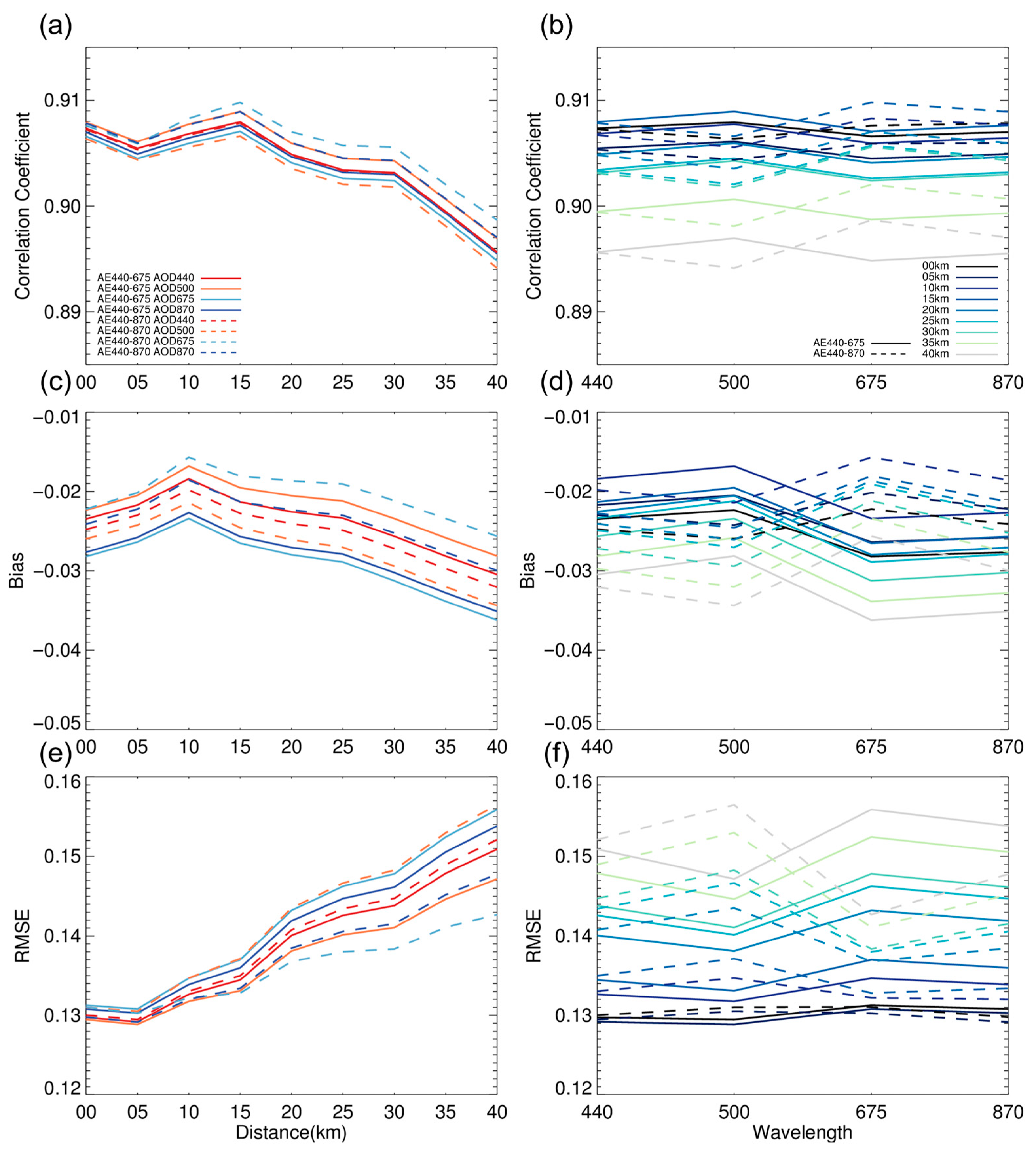
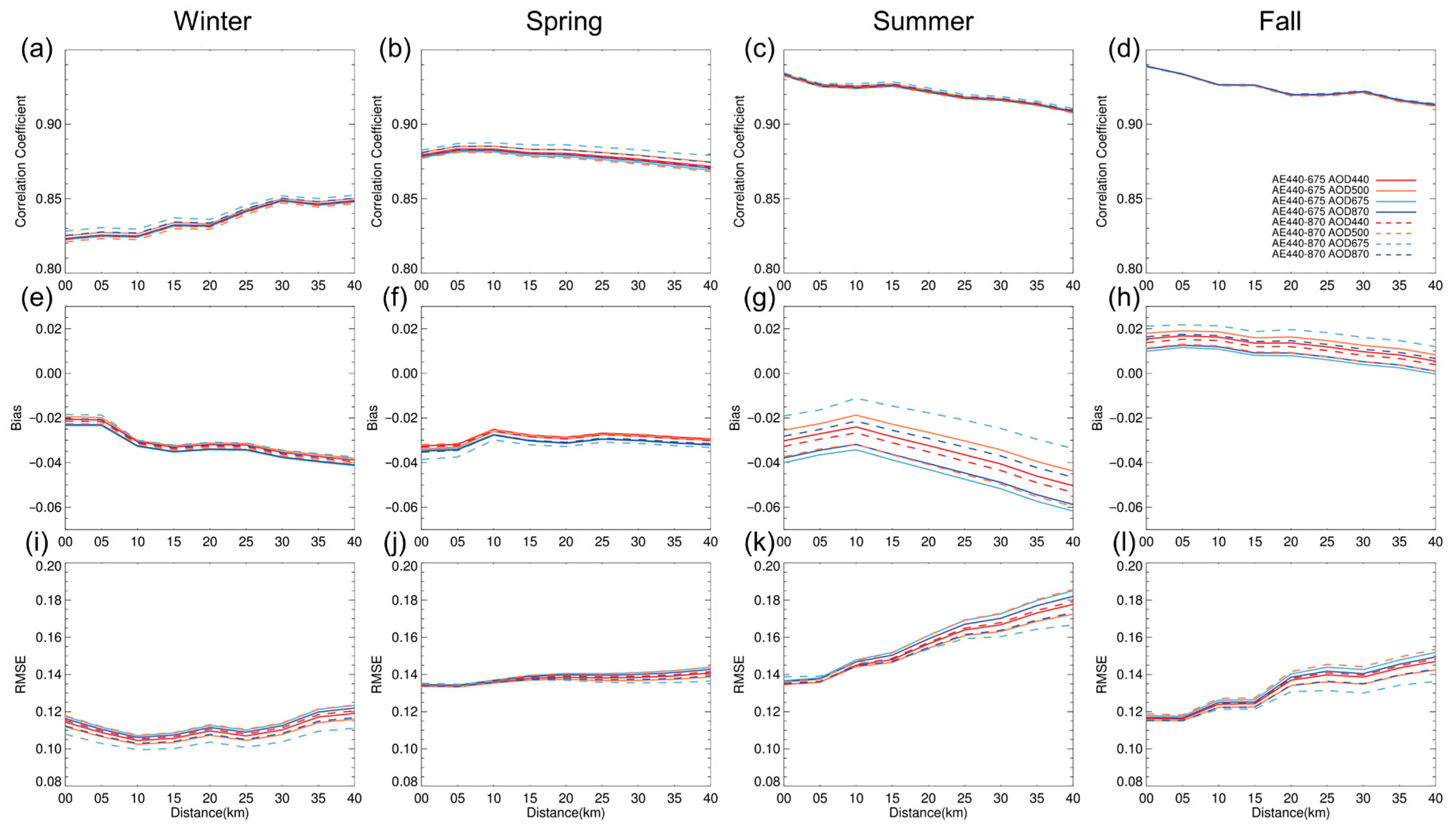
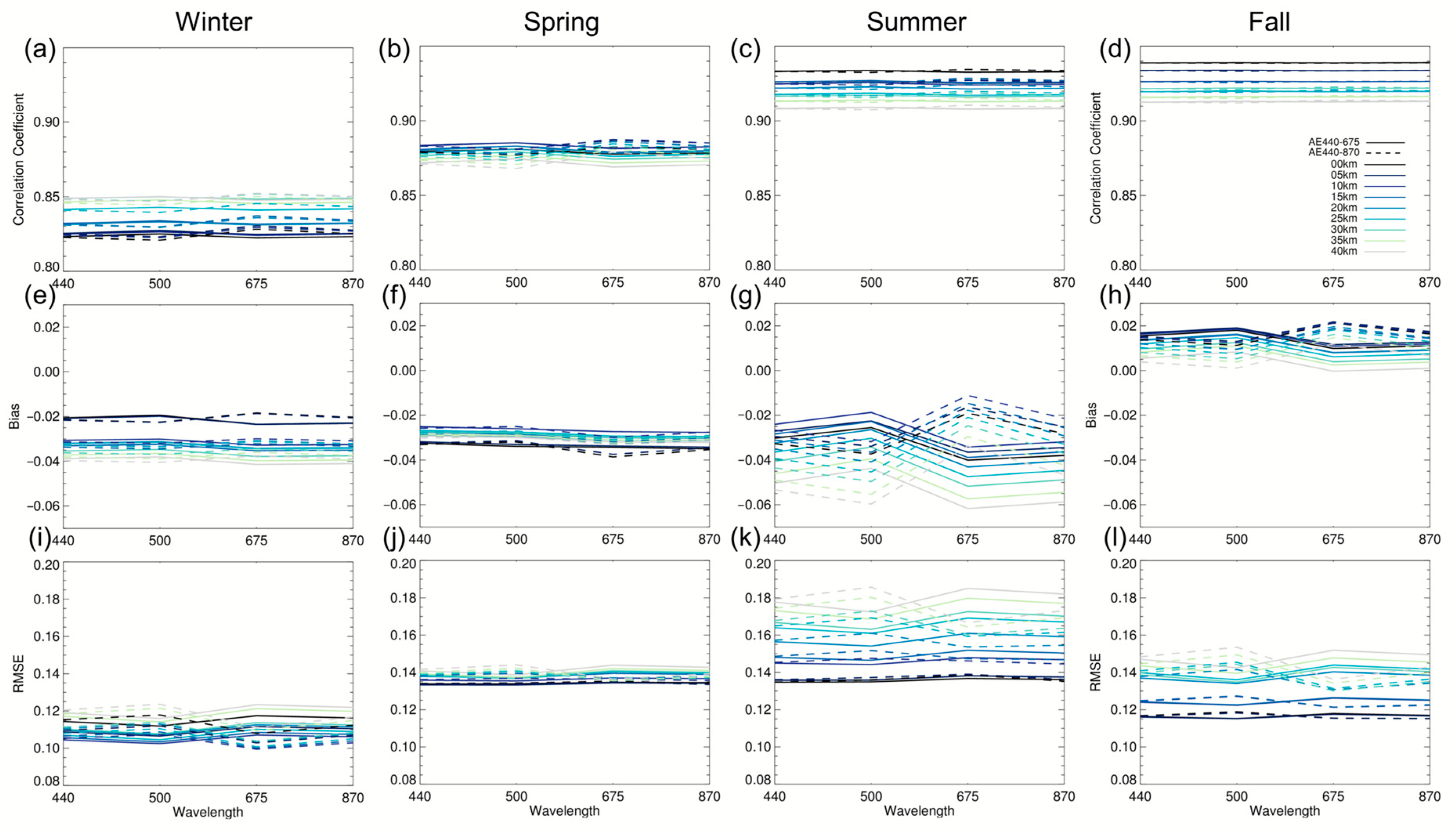
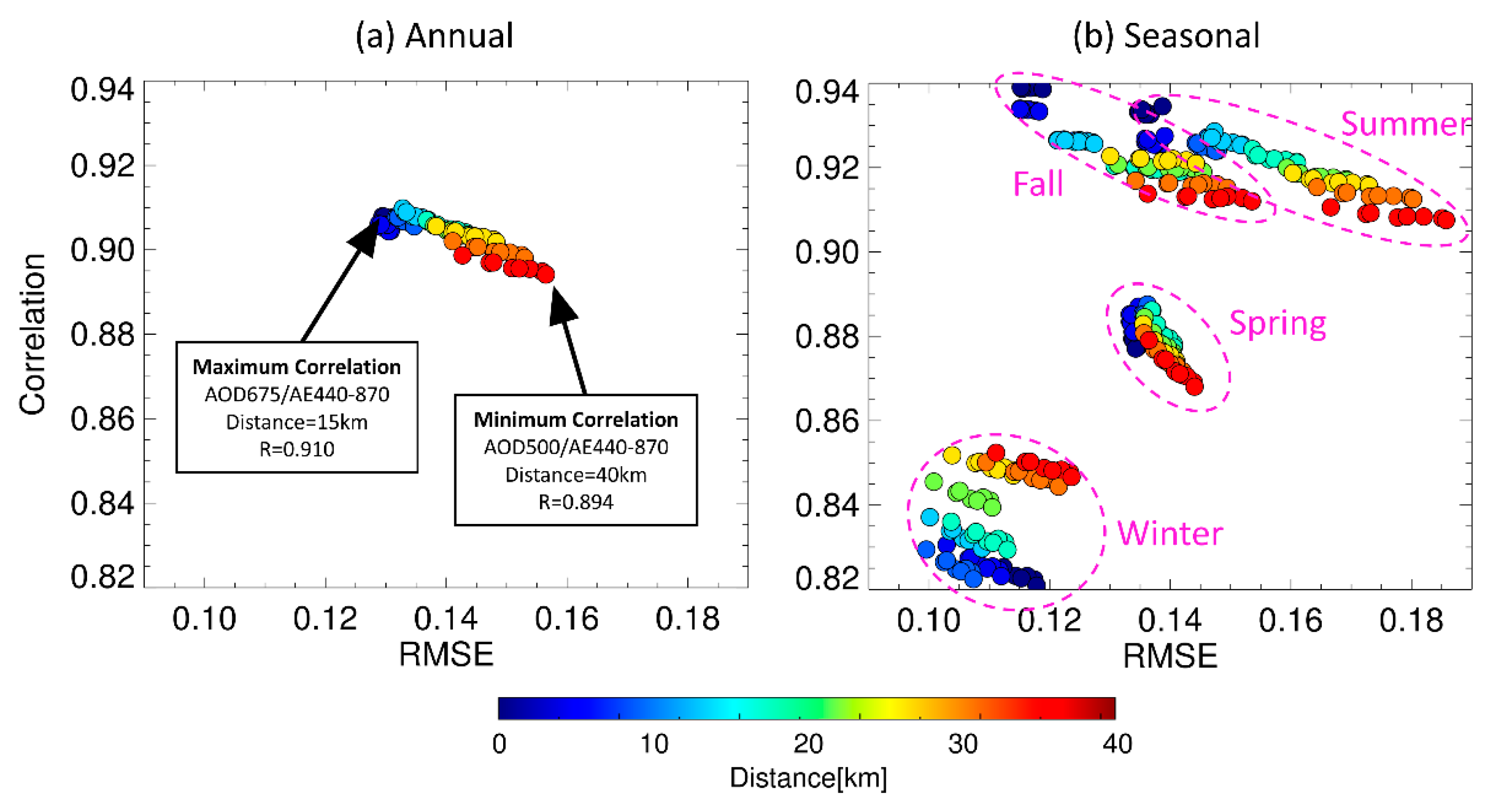


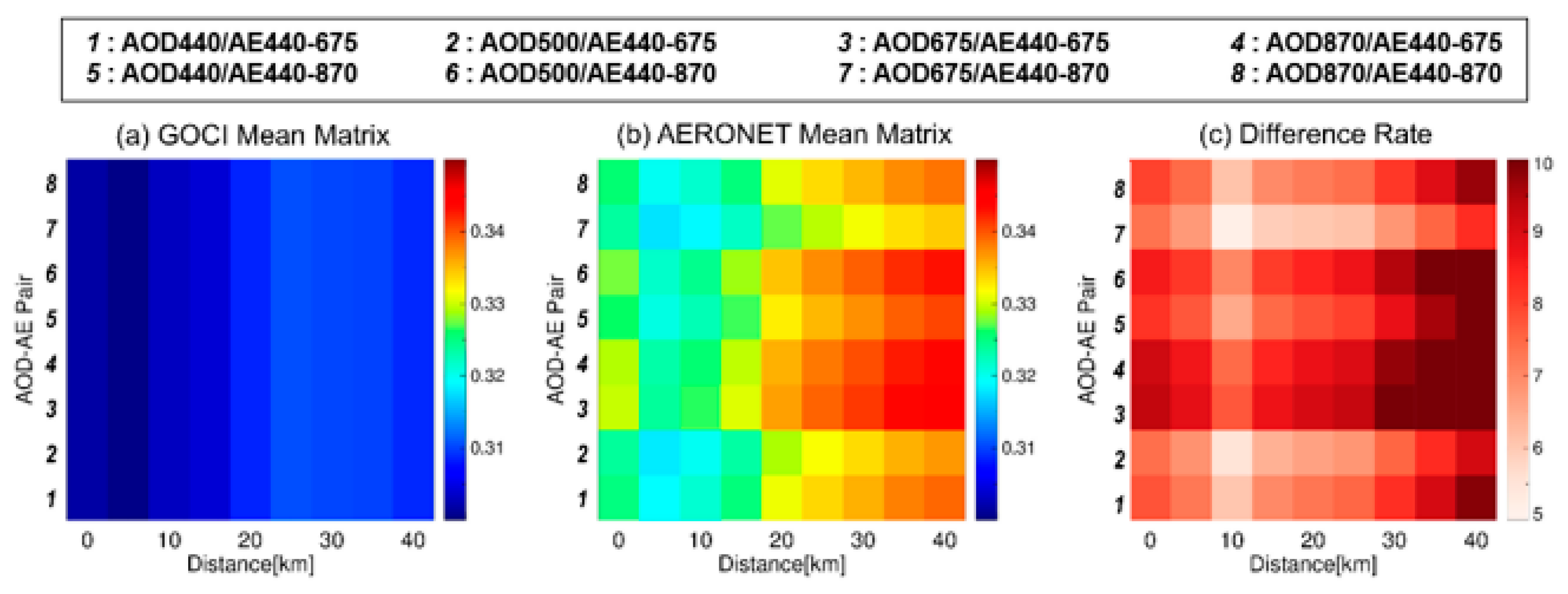

| AERONET Stations | Longitude (Degree) | Latitude (Degree) | Elevation (m) |
|---|---|---|---|
| Alishan | 120.81341 | 23.50844 | 2416 |
| Anmyon | 126.33019 | 36.538537 | 47 |
| Baengnyeong | 124.63028 | 37.966111 | 136 |
| Bamboo | 121.53527 | 25.186711 | 1050 |
| Beijing | 116.38137 | 39.97689 | 92 |
| Beijing-CAMS | 116.31667 | 39.93333 | 106 |
| Cape_Fuguei_Station | 121.53786 | 25.297452 | 40 |
| Chen-Kung_Univ | 120.20466 | 22.993419 | 50 |
| Chiayi | 120.49598 | 23.495975 | 62 |
| Chiba_University | 140.1038 | 35.6247 | 60 |
| Dongsha_Island | 116.72883 | 20.698556 | 5 |
| Douliu | 120.5448 | 23.7117 | 60 |
| DRAGON_Mokpo_NU | 126.43736 | 34.91342 | 26 |
| DRAGON_NIER | 126.63971 | 37.56893 | 26.9 |
| EPA-NCU | 121.18548 | 24.967533 | 144 |
| Fukuoka | 130.475 | 33.524 | 30 |
| Gangneung_WNU | 128.867 | 37.771 | 60 |
| Gosan_SNU | 126.16167 | 33.292222 | 72 |
| Gwangju_GIST | 126.84314 | 35.228278 | 52 |
| Hankuk_UFS | 127.26582 | 37.33883 | 167 |
| Hokkaido_University | 141.3407 | 43.0755 | 59 |
| Ieodo_Station | 125.18245 | 32.122953 | 29 |
| KORUS_Baeksa | 127.5691 | 37.41156 | 64 |
| KORUS_Daegwallyeong | 128.75872 | 37.68712 | 837 |
| KORUS_Iksan | 127.0052 | 35.9622 | 84 |
| KORUS_Kyungpook_NU | 128.60642 | 35.889989 | 65 |
| KORUS_Mokpo_NU | 126.43736 | 34.91342 | 26 |
| KORUS_NIER | 126.63971 | 37.56893 | 26.9 |
| KORUS_Olympic_Park | 127.12418 | 37.52165 | 45 |
| KORUS_Songchon | 127.48946 | 37.33849 | 90 |
| KORUS_Taehwa | 127.31033 | 37.31248 | 152 |
| KORUS_UNIST_Ulsan | 129.1897 | 35.5819 | 106 |
| Lulin | 120.87361 | 23.468611 | 2868 |
| Niigata | 138.942 | 37.846 | 10 |
| Noto | 137.13694 | 37.334444 | 200 |
| Osaka | 135.59063 | 34.650933 | 50 |
| Osaka31 | 135.5881 | 34.65179 | 50 |
| Pusan_NU | 129.08249 | 35.235354 | 78 |
| Seoul_SNU | 126.95111 | 37.458056 | 116 |
| Shirahama | 135.35692 | 33.69345 | 10 |
| Socheongcho | 124.73804 | 37.423133 | 28 |
| Taihu | 120.21533 | 31.421 | 20 |
| Taipei_CWB | 121.53837 | 25.014683 | 26 |
| Ussuriysk | 132.1635 | 43.7004 | 280 |
| XiangHe | 116.9615 | 39.7536 | 36 |
| Yonsei_University | 126.93479 | 37.56443 | 97 |
Disclaimer/Publisher’s Note: The statements, opinions and data contained in all publications are solely those of the individual author(s) and contributor(s) and not of MDPI and/or the editor(s). MDPI and/or the editor(s) disclaim responsibility for any injury to people or property resulting from any ideas, methods, instructions or products referred to in the content. |
© 2023 by the authors. Licensee MDPI, Basel, Switzerland. This article is an open access article distributed under the terms and conditions of the Creative Commons Attribution (CC BY) license (https://creativecommons.org/licenses/by/4.0/).
Share and Cite
Kim, M.; Lee, K.; Choi, M. Spectral and Spatial Dependencies in the Validation of Satellite-Based Aerosol Optical Depth from the Geostationary Ocean Color Imager Using the Aerosol Robotic Network. Remote Sens. 2023, 15, 3621. https://doi.org/10.3390/rs15143621
Kim M, Lee K, Choi M. Spectral and Spatial Dependencies in the Validation of Satellite-Based Aerosol Optical Depth from the Geostationary Ocean Color Imager Using the Aerosol Robotic Network. Remote Sensing. 2023; 15(14):3621. https://doi.org/10.3390/rs15143621
Chicago/Turabian StyleKim, Mijeong, Kyunghwa Lee, and Myungje Choi. 2023. "Spectral and Spatial Dependencies in the Validation of Satellite-Based Aerosol Optical Depth from the Geostationary Ocean Color Imager Using the Aerosol Robotic Network" Remote Sensing 15, no. 14: 3621. https://doi.org/10.3390/rs15143621
APA StyleKim, M., Lee, K., & Choi, M. (2023). Spectral and Spatial Dependencies in the Validation of Satellite-Based Aerosol Optical Depth from the Geostationary Ocean Color Imager Using the Aerosol Robotic Network. Remote Sensing, 15(14), 3621. https://doi.org/10.3390/rs15143621






